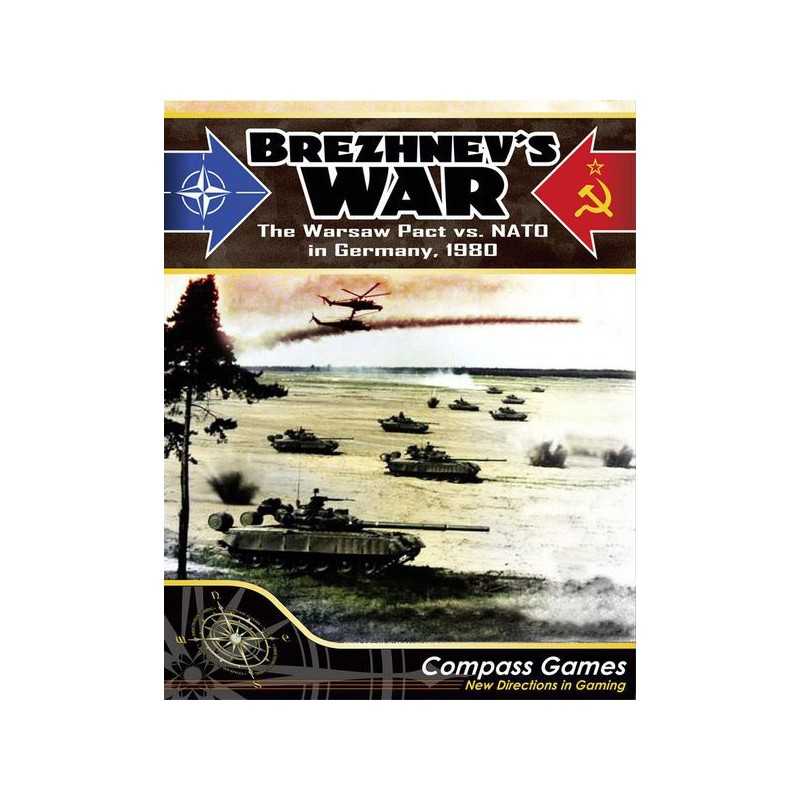- -10%







Brezhnev’s War: NATO vs. the Warsaw Pact in Germany, 1980 enables two players to game the first month of a hypothesized communist invasion of Western Europe sometime between the fall of Saigon and the start of the Soviet intervention in Afghanistan.
In stock
Available on: 28/09/2018

Related games

No customer questions for the moment.





Llevo comprando juegos de mesa en Planeton Games desde el 2009. Gracias a esta tienda y al excelente servicio que presta Jon a sus clientes, tengo ahora una respetable colección de juegos que en mi país sería imposible conseguir. ¡Felicitaciones...





Llevo mas de cuatro años como cliente y estoy encantado, el servicio es muy bueno y la atención completamente personalizada. Incluso he hecho peticiones para buscar cosas que no tenían inicialmente en catalogo y la respuesta siempre ha sido...





Ha sido la primera vez que encargo algo en esta página y soy un comprador habitual de juegos. Fue elegida esta página porque tenían los juegos que estaba buscando y el precio era mejor que el de otras, en las que estaba acostumbrado comprar.El...





Primera vez que realizo una compra desde españa y la verdad que es altamente recomendado. Al principio estaba algo reacio a comprar algo que no fuera en EEUU, pero llego sin problemas, en el plazo que dijeron, muy bien envuelto.Te responden todas...





Tomé tiempo para pensar que juego quería, pero cuando llegó el momento de comprar dudé, muchos juegos. Si te pasa lláma, eso hice yo y soberbia la atención, y el juego en casa diligentemente en 24 horas. Gracias de un novel, mil elogios.





Es una de las mejores páginas para comprar juegos, super confiable, cumplen al pie de la letra todo, un servicio que podría calificar de PREMIUM!. Muchas gracias a todo el equipo de Planetogames!\r\nAbrazo cordial desde el otro lado del charco!





Nr.1 Wargames and Family Games store in the world. Bestest customer service that you can find. Hugely recommended store! Congrats to your new awesome website.





Envío muy rápido. El producto estaba embalado muy bien.
 Game description
Game descriptionBrezhnev’s War: NATO vs. the Warsaw Pact in Germany, 1980 enables two players to game the first month of a hypothesized communist invasion of Western Europe sometime between the fall of Saigon and the start of the Soviet intervention in Afghanistan. It was during that period the conventional “correlation of forces” between the two hostile alliances most favored the communists.
The scenario portrayed is the one that was most anticipated and feared by NATO’s intelligence analysts at the time. That is, despite their knowledge of the existence of Soviets plans to begin such a war with massive chemical and nuclear strikes, the West’s military planners gave those schemes little credence. They knew the Soviets understood such a strategy would bring on immediate nuclear retaliation by the West. That would’ve ended the war as quickly as it began – mostly likely along with all of civilization – with no winner identifiable.
What was feared then was, one fine summer day, the Soviet units in East Germany would move out from eating breakfast in their mess halls and roll across the border into West Germany. It would’ve been a “come as you are” kind of war, the aim of which would’ve been to blitz across Germany – using only conventional weaponry – in under a month.
The Soviets would then have called for a ceasefire before any nuclear or chemical weapons had been detonated or the massive economic power of the Atlantic community brought to bear. With that, West Germany – the geo-strategic lynchpin of NATO in Europe – would’ve been neutralized and its Ruhr industrial area – then as now, one of the most important manufacturing centers on the planet – entirely wrecked. That would’ve caused a shift in the global balance of power in favor of the Kremlin, setting them up to deliver the knockout blow later.
The 50” x 35” map covers the core area of the Federal Republic of Germany at 6.66 miles (10.8 km) per hex. There are 352 large-size (5/8”) unit counters, representing the divisions and brigades immediately on scene at the time, along with the masses of other units that could’ve been sent as reinforcements. Each of the 10 game turns represent three days of real time.
The turn sequence uses the classic fight-move or move-fight structure. Special rules account for heliborne units, Spetsnaz, the ultra-elite Soviet Eighth Guards and Guards Airborne Armies, East German and Czechoslovakian disloyalty, ranged Soviet artillery divisions, air power, supply, the criticality of Frankfurt for US operations, paradrops, German territorials, electronic warfare and variable Soviet victory objectives.
The overall system is simple, at about 6 on the 1-10 scale. Two experienced players can get through a match in about four to six hours.
 Reviews
ReviewsThere are no available reviews. Write your review.
You are only allowed to leave 1 review(s) for this product

Brezhnev’s War: NATO vs. the Warsaw Pact in Germany, 1980 enables two players to game the first month of a hypothesized communist invasion of Western Europe sometime between the fall of Saigon and the start of the Soviet intervention in Afghanistan.
@CUSTOMER_NAME@
@AUTHOR_PROFILE@ @COMMENT_ISO_COUNTRY@ @VERIFY_PURCHASE@@COMMENT_TITLE@
@COMMENT_COMMENT@